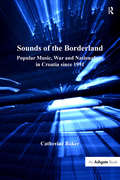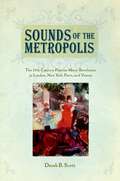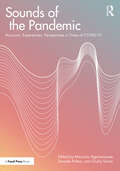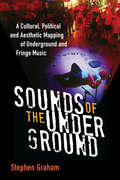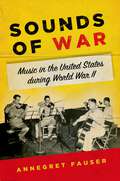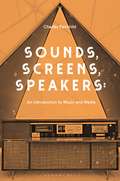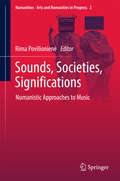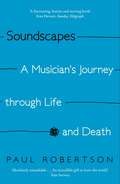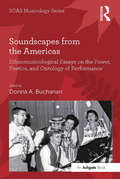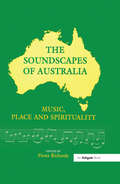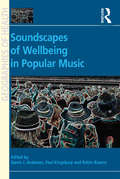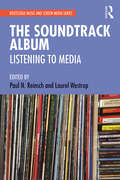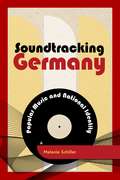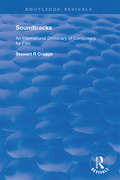- Table View
- List View
Sounds of the Borderland: Popular Music, War and Nationalism in Croatia since 1991
by Catherine BakerSounds of the Borderland is the first book-length study of how popular music became a medium for political communication and contested identification during and after Croatia's war of independence from Yugoslavia. It extends existing cultural studies literature on music, politics and the state, which has largely been grounded in Western European and North American political systems. It also responds to an emerging fascination with the culture and politics of contemporary south-east Europe, expanding scholarship on the post-Yugoslav conflicts by going on to encompass significant social and political changes into the present day. The outbreak of war in 1991 saw almost every professional musician in Croatia take part in a wave of patriotic music-making and the powerful state television system strive to bring popular music under its control. As the political imperative shifted from securing national survival to consolidating a homogenous nation-state, the music industry responded with several strategies for creating a national popular music, producing messages about the nation and, in the ongoing debates over the origins of the folk music that inspired many songs, a way to define the nation by expressing what Croatia was not. The war on ethnic ambiguity which cut through individuals' social and creative lives played out across the airwaves, sales racks and gossip columns of a small country that imagined itself a historical and cultural borderland. These explicit and implicit narratives of nationhood connect many political phases: the months of fiercest fighting, the stabilised front, the uneasy post-war years when the symbolic frontline region of eastern Slavonia had still not returned to Croatian sovereignty, the euphoria and instability after the end of the Tudjman regime in 2000, and Croatia's fraught journey towards the European Union. Baker's book provides valuable insight into the role of music in a wartime and post-conflict society and will be essential reading for researchers and students interested in south-east Europe or the transformation of entertainment during and after conflict.
Sounds of the Metropolis: The 19th Century Popular Music Revolution in London, New York, Paris and Vienna
by Derek B. ScottThe phrase "popular music revolution" may instantly bring to mind such twentieth-century musical movements as jazz and rock 'n' roll. In Sounds of the Metropolis, however, Derek Scott argues that the first popular music revolution actually occurred in the nineteenth century, illustrating how a distinct group of popular styles first began to assert their independence and values. He explains the popular music revolution as driven by social changes and the incorporation of music into a system of capitalist enterprise, which ultimately resulted in a polarization between musical entertainment (or "commercial" music) and "serious" art. He focuses on the key genres and styles that precipitated musical change at that time, and that continued to have an impact upon popular music in the next century. By the end of the nineteenth century, popular music could no longer be viewed as watered down or more easily assimilated art music; it had its own characteristic techniques, forms, and devices. As Scott shows, "popular" refers here, for the first time, not only to the music's reception, but also to the presence of these specific features of style. The shift in meaning of "popular" provided critics with tools to condemn music that bore the signs of the popular-which they regarded as fashionable and facile, rather than progressive and serious. A fresh and persuasive consideration of the genesis of popular music on its own terms, Sounds of the Metropolis breaks new ground in the study of music, cultural sociology, and history.
Sounds of the Metropolis: The 19th Century Popular Music Revolution in London, New York, Paris and Vienna
by Derek B. ScottThe phrase "popular music revolution" may instantly bring to mind such twentieth-century musical movements as jazz and rock 'n' roll. In Sounds of the Metropolis, however, Derek Scott argues that the first popular music revolution actually occurred in the nineteenth century, illustrating how a distinct group of popular styles first began to assert their independence and values. He explains the popular music revolution as driven by social changes and the incorporation of music into a system of capitalist enterprise, which ultimately resulted in a polarization between musical entertainment (or "commercial" music) and "serious" art. He focuses on the key genres and styles that precipitated musical change at that time, and that continued to have an impact upon popular music in the next century. By the end of the nineteenth century, popular music could no longer be viewed as watered down or more easily assimilated art music; it had its own characteristic techniques, forms, and devices. As Scott shows, "popular" refers here, for the first time, not only to the music's reception, but also to the presence of these specific features of style. The shift in meaning of "popular" provided critics with tools to condemn music that bore the signs of the popular-which they regarded as fashionable and facile, rather than progressive and serious. A fresh and persuasive consideration of the genesis of popular music on its own terms, Sounds of the Metropolis breaks new ground in the study of music, cultural sociology, and history.
Sounds of the Pandemic: Accounts, Experiences, Perspectives in Times of COVID-19
by Maurizio Agamennone Daniele Palma Giulia SarnoSounds of the Pandemic offers one of the first critical analyses of the changes in sonic environments, artistic practice, and listening behaviour caused by the Coronavirus outbreak. This multifaceted collection provides a detailed picture of a wide array of phenomena related to sound and music, including soundscapes, music production, music performance, and mediatisation processes in the context of COVID-19. It represents a first step to understanding how the pandemic and its by-products affected sound domains in terms of experiences and practices, representations, collective imaginaries, and socio-political manipulations. This book is essential reading for students, researchers, and practitioners working in the realms of music production and performance, musicology and ethnomusicology, sound studies, and media and cultural studies.
Sounds of the Pandemic: Accounts, Experiences, Perspectives in Times of COVID-19
by Maurizio Agamennone Daniele Palma Giulia SarnoSounds of the Pandemic offers one of the first critical analyses of the changes in sonic environments, artistic practice, and listening behaviour caused by the Coronavirus outbreak. This multifaceted collection provides a detailed picture of a wide array of phenomena related to sound and music, including soundscapes, music production, music performance, and mediatisation processes in the context of COVID-19. It represents a first step to understanding how the pandemic and its by-products affected sound domains in terms of experiences and practices, representations, collective imaginaries, and socio-political manipulations. This book is essential reading for students, researchers, and practitioners working in the realms of music production and performance, musicology and ethnomusicology, sound studies, and media and cultural studies.
Sounds of the Underground: A Cultural, Political and Aesthetic Mapping of Underground and Fringe Music (Tracking Pop)
by Stephen GrahamIn basements, dingy backrooms, warehouses, and other neglected places around the world music is being made that doesn't fit neatly into popular or classical categories and genres, whose often extreme sounds and tiny concerts hover on the fringes of these commercial and cultural mainstreams. The term “underground music” as it’s being used here connects various forms of music-making that exist outside or on the fringes of mainstream institutions and culture, such as noise, free improvisation, and extreme metal. This is music that makes little money, that’s noisy and exploratory in sound and that’s largely independent from both the market and from traditional high art institutions. It sometimes exists at the fringes of these commercial and cultural institutions, as for example with experimental metal or improv, but for the most part it’s removed from the mainstream, “underground,” as we see with noise artists such as Werewolf Jerusalem or Ramleh, obscure black metal artists such as Lord Foul, and improvisers such as Maggie Nicols. In response to a lack of previous scholarly discussion, Graham provides a cultural, political, and aesthetic mapping of this broad territory. By outlining the historical background but focusing on the digital age, the underground and its fringes can be seen as based in radical anti-capitalist politics or radical aesthetics while also being tied to the political contexts and structures of late capitalism. The book explores these various ideas of separation and captures, through interviews and analysis, a critical account of both the music and the political and cultural economy of the scene.
Sounds of War: Music in the United States during World War II
by Annegret FauserWhat role did music play in the United States during World War II? How did composers reconcile the demands of their country and their art as America mobilized both militarily and culturally for war? Annegret Fauser explores these and many other questions in the first in-depth study of American concert music during World War II. While Dinah Shore, Duke Ellington, and the Andrew Sisters entertained civilians at home and G.I.s abroad with swing and boogie-woogie, Fauser shows it was classical music that truly distinguished musical life in the wartime United States. Classical music in 1940s America had a ubiquitous cultural presence--whether as an instrument of propaganda or a means of entertainment, recuperation, and uplift--that is hard to imagine today, and Fauser suggests that no other war enlisted culture in general and music in particular so consciously and unequivocally as World War II. Indeed, the day after the attack on Pearl Harbor, Group Theatre director Harold Clurman wrote to his cousin, Aaron Copland: "So you're back in N.Y. . . ready to defend your country in her hour of need with lectures, books, symphonies!" Copland was in fact involved in propaganda missions of the Office of War Information, as were Marc Blitzstein, Elliott Carter, Henry Cowell, Roy Harris, and Colin McPhee. It is the works of these musical greats--as well as many other American and exiled European composers who put their talents to patriotic purposes--that form the core of Fauser's enlightening account. Drawing on music history, aesthetics, reception history, and cultural history, Sounds of War recreates the remarkable sonic landscape of the World War II era and offers fresh insight to the role of music during wartime.
Sounds of War: Music in the United States during World War II
by Annegret FauserWhat role did music play in the United States during World War II? How did composers reconcile the demands of their country and their art as America mobilized both militarily and culturally for war? Annegret Fauser explores these and many other questions in the first in-depth study of American concert music during World War II. While Dinah Shore, Duke Ellington, and the Andrew Sisters entertained civilians at home and G.I.s abroad with swing and boogie-woogie, Fauser shows it was classical music that truly distinguished musical life in the wartime United States. Classical music in 1940s America had a ubiquitous cultural presence--whether as an instrument of propaganda or a means of entertainment, recuperation, and uplift--that is hard to imagine today, and Fauser suggests that no other war enlisted culture in general and music in particular so consciously and unequivocally as World War II. Indeed, the day after the attack on Pearl Harbor, Group Theatre director Harold Clurman wrote to his cousin, Aaron Copland: "So you're back in N.Y. . . ready to defend your country in her hour of need with lectures, books, symphonies!" Copland was in fact involved in propaganda missions of the Office of War Information, as were Marc Blitzstein, Elliott Carter, Henry Cowell, Roy Harris, and Colin McPhee. It is the works of these musical greats--as well as many other American and exiled European composers who put their talents to patriotic purposes--that form the core of Fauser's enlightening account. Drawing on music history, aesthetics, reception history, and cultural history, Sounds of War recreates the remarkable sonic landscape of the World War II era and offers fresh insight to the role of music during wartime.
Sounds, Screens, Speakers: An Introduction to Music and Media
by Charles FairchildSounds, Screens, Speakers provides a broadly comprehensive survey of the emerging field of music and media. Music has been present at the advent of nearly every new media form since the turn of the 20th century. Whether we look at the start of sound recording, film, television or the Internet, music has been a crucial participant in the social changes brought about by these new tools for making and listening to music. This book examines such changes starting in the late 19th century to the present. From the introduction of the microphone all the way through to music in reality television, the purpose of each section is not simply to move chronologically towards the present, but to focus especially on the tangible social relationships created through specific forms of mediation. With readings at the end of most chapters, key questions to facilitate additional discovery and research, and direction to additional readings and resources on popular websites and news sources, this text serves as the ideal introduction to popular music and media.
Sounds, Screens, Speakers: An Introduction to Music and Media
by Dr Charles FairchildSounds, Screens, Speakers provides a broadly comprehensive survey of the emerging field of music and media. Music has been present at the advent of nearly every new media form since the turn of the 20th century. Whether we look at the start of sound recording, film, television or the Internet, music has been a crucial participant in the social changes brought about by these new tools for making and listening to music. This book examines such changes starting in the late 19th century to the present. From the introduction of the microphone all the way through to music in reality television, the purpose of each section is not simply to move chronologically towards the present, but to focus especially on the tangible social relationships created through specific forms of mediation. With readings at the end of most chapters, key questions to facilitate additional discovery and research, and direction to additional readings and resources on popular websites and news sources, this text serves as the ideal introduction to popular music and media.
Sounds, Societies, Significations: Numanistic Approaches to Music (Numanities - Arts and Humanities in Progress #2)
by Rima PovilionienėThis edited book covers many topics in musicological literature, gathering various approaches to music studies that encapsulate the vivid relation music has to society. It focusses on repertoires and geographical areas that have not previously been well frequented in musicology. As readers will see, music has many roles to play in society. Music can be a generator of social phenomena, or a result of them; it can enhance or activate social actions, or simply co-habit with them. Above all, music has a stable position within society, in that it actively participates in it. Music can either describe or prescribe social aspects; musicians may have a certain position/role in society (e.g., the “popstar” as fashion leader, spokesman for political issues, etc.). Depending on the type of society, music may have a certain “meaning” or “function” (music does not mean the same thing everywhere in the world). Lastly, music can define a society, and it is not uncommon for it to best define a particular historical moment. Case-studies in this work provide visibility for musical cultures that are rarely exposed in the dominant musicological discourse. Several contributions combine musicological analysis with "insider-musician" points of view. Some essays in the collection address the cultural clash between certain types of music/musicians and the respective institutional counterparts, while certain contributing authors draw on experimental research findings. Throughout this book we see how musics are socially significant, and - at the same time - that societies are musically significant too. Thus the book will appeal to musicologists, cultural scholars and semioticians, amongst others.
Soundscapes: A Musician's Journey through Life and Death
by Paul RobertsonFor nearly forty years Paul Robertson performed throughout the world as First Violinist of the internationally renowned Medici String Quartet, of which he was a founder member. In 2008 the main artery to Paul's heart ruptured, leading to him dying on the operating-table, and then being resuscitated. Paul subsequently hovered in a deep coma for six weeks, close to death and experiencing visions, affording him profound insights into the relationship between music and the subconscious When he came to he felt he had been reborn - fundamentally, a different person - and not just because the left side of his body was partially paralysed. Instead, he woke with a completely new acceptance of the meaning of death, and a belief in life beyond. Now 64 years-old, Paul has decided not to undergo any more surgery, facing a very uncertain future and living on borrowed time. In this book Paul reflects on his musical training, his insights into the difficult realities of ensemble playing, and about the possible meaning of his experiences in both life and near-death. This extraordinary and poignant memoir will be for all musicians, spiritual thinkers and musical laymen who have engaged with the rigours of learning music.
Soundscapes from the Americas: Ethnomusicological Essays on the Power, Poetics, and Ontology of Performance (SOAS Studies in Music)
by Donna A. BuchananDedicated to the late Gerard Béhague (1937-2005), whose pioneering work in Latin American music, popular culture, and performance studies contributed extensively to ethnomusicological discourse in the 1970s-1990s, this anthology offers comparative perspectives on the evolving legacy of performance ethnography in socio-musical analysis. President of the Society for Ethnomusicology from 1979-81, editor of its journal, Ethnomusicology, from 1974-78, and founder and editor of the trilingual Latin American Music Review from 1980 until his death, Béhague also established the ethnomusicology graduate program at the University of Texas at Austin in 1974, thereby influencing the training and thinking of dozens of the field’s practitioners. Among these are the volume’s eight authors, whose contributions reflect the heritage but also contemporary trajectories of Béhague’s scholarly concerns. Prefaced by an essay outlining key developments in the ethnography of performance paradigm, the volume’s seven case studies portray snapshots of musical life in representative communities of the Americas, including the southwestern and Pacific United States, Puerto Rico, Bolivia, Chile, Cuba, and Ecuador. Situated in milieus ranging from the indigenous festivals of the Andean highlands, to the competitive public gatherings of poet-singers in post-Pinochet Chile, to the Puerto Rican dance halls of the Hawaiian islands, these studies pose anthropological inquiries into the ontology of performance practice, the social power of poetic performativity, and the experience and embodiment of sound in place.
Soundscapes from the Americas: Ethnomusicological Essays on the Power, Poetics, and Ontology of Performance (SOAS Studies in Music)
by Donna A. BuchananDedicated to the late Gerard Béhague (1937-2005), whose pioneering work in Latin American music, popular culture, and performance studies contributed extensively to ethnomusicological discourse in the 1970s-1990s, this anthology offers comparative perspectives on the evolving legacy of performance ethnography in socio-musical analysis. President of the Society for Ethnomusicology from 1979-81, editor of its journal, Ethnomusicology, from 1974-78, and founder and editor of the trilingual Latin American Music Review from 1980 until his death, Béhague also established the ethnomusicology graduate program at the University of Texas at Austin in 1974, thereby influencing the training and thinking of dozens of the field’s practitioners. Among these are the volume’s eight authors, whose contributions reflect the heritage but also contemporary trajectories of Béhague’s scholarly concerns. Prefaced by an essay outlining key developments in the ethnography of performance paradigm, the volume’s seven case studies portray snapshots of musical life in representative communities of the Americas, including the southwestern and Pacific United States, Puerto Rico, Bolivia, Chile, Cuba, and Ecuador. Situated in milieus ranging from the indigenous festivals of the Andean highlands, to the competitive public gatherings of poet-singers in post-Pinochet Chile, to the Puerto Rican dance halls of the Hawaiian islands, these studies pose anthropological inquiries into the ontology of performance practice, the social power of poetic performativity, and the experience and embodiment of sound in place.
The Soundscapes of Australia: Music, Place and Spirituality
by Fiona RichardsAustralia offers tremendous scope for understanding the relationship between music, spirituality and landscape. This major, generously-illustrated new volume examines, in fifteen chapters, some of the ways in which composers and performers have attempted to convey a sense of the Australian landscape through musical means. The book embraces the different approaches of ethnomusicology, gender studies, musical analysis, performance studies and cultural history. Ranging across the country, from remote parts of the Northern Territory to the bustling east coast cities, from Tasmanian wilderness to tropical Queensland, the book includes references to art and literature as well as music. Issues of national identity, belonging and aboriginalization are an integral part of the book, with indigenous responses to place examined alongside music from the western orchestral, chamber and choral repertories. The book provides valuable insight into a wide range of music inspired by Australia, from the Yanyuwa people to Jewish communities in Victoria; from Peter Sculthorpe's opera Quiros to the work of European expats living in Australia before the Second World War; from historic Ealing film scores to contemporary sound installations. The work of many significant composers is discussed in detail, among them Ross Edwards, Barry Conyngham, David Lumsdaine, Anne Boyd and Fritz Hart. Throughout the book there is a sense of the vibrancy and diversity of the music inspired by the sights and sounds of the Australian landscape.
The Soundscapes of Australia: Music, Place and Spirituality
by Fiona RichardsAustralia offers tremendous scope for understanding the relationship between music, spirituality and landscape. This major, generously-illustrated new volume examines, in fifteen chapters, some of the ways in which composers and performers have attempted to convey a sense of the Australian landscape through musical means. The book embraces the different approaches of ethnomusicology, gender studies, musical analysis, performance studies and cultural history. Ranging across the country, from remote parts of the Northern Territory to the bustling east coast cities, from Tasmanian wilderness to tropical Queensland, the book includes references to art and literature as well as music. Issues of national identity, belonging and aboriginalization are an integral part of the book, with indigenous responses to place examined alongside music from the western orchestral, chamber and choral repertories. The book provides valuable insight into a wide range of music inspired by Australia, from the Yanyuwa people to Jewish communities in Victoria; from Peter Sculthorpe's opera Quiros to the work of European expats living in Australia before the Second World War; from historic Ealing film scores to contemporary sound installations. The work of many significant composers is discussed in detail, among them Ross Edwards, Barry Conyngham, David Lumsdaine, Anne Boyd and Fritz Hart. Throughout the book there is a sense of the vibrancy and diversity of the music inspired by the sights and sounds of the Australian landscape.
Soundscapes of Wellbeing in Popular Music (Geographies of Health Series)
by Gavin J. Andrews Paul Kingsbury Robin KearnsUnearthing the messy and sprawling interrelationships of place, wellbeing, and popular music, this book explores musical soundscapes of health, ranging from activism to international charity, to therapeutic treatments and how wellbeing is sought and attained in contexts of music. Drawing on critical social theories of the production, circulation, and consumption of popular music, the book gathers together diverse insights from geographers and musicologists. Popular music has become increasingly embedded in complex and often contradictory discourses of wellbeing. For instance, some new genres and sub-cultures of popular music are associated with violence, drug-use, and the angst of living, yet simultaneously define the hopes and dreams of millions of young people. At a service level, popular music is increasingly used as a therapeutic modality in holistic medicine, as well as in conventional health care and public health practice. The genre of popular music, then, is fundamental to human wellbeing as an active and central part of people’s emotional lives. By conceptually and empirically foregrounding place, this book demonstrates how - music whether from particular places, about particular places, or played in particular places ” is a crucial component of health and wellbeing.
Soundscapes of Wellbeing in Popular Music (Geographies of Health Series)
by Paul Kingsbury Gavin J. Andrews Robin KearnsUnearthing the messy and sprawling interrelationships of place, wellbeing, and popular music, this book explores musical soundscapes of health, ranging from activism to international charity, to therapeutic treatments and how wellbeing is sought and attained in contexts of music. Drawing on critical social theories of the production, circulation, and consumption of popular music, the book gathers together diverse insights from geographers and musicologists. Popular music has become increasingly embedded in complex and often contradictory discourses of wellbeing. For instance, some new genres and sub-cultures of popular music are associated with violence, drug-use, and the angst of living, yet simultaneously define the hopes and dreams of millions of young people. At a service level, popular music is increasingly used as a therapeutic modality in holistic medicine, as well as in conventional health care and public health practice. The genre of popular music, then, is fundamental to human wellbeing as an active and central part of people’s emotional lives. By conceptually and empirically foregrounding place, this book demonstrates how - music whether from particular places, about particular places, or played in particular places ” is a crucial component of health and wellbeing.
The Soundtrack Album: Listening to Media
by Paul Reinsch Laurel WestrupThe Soundtrack Album: Listening to Media offers the first sustained exploration of the soundtrack album as a distinctive form of media. Soundtrack albums have been part of our media and musical landscape for decades, enduring across formats from vinyl and 8-tracks to streaming playlists. This book makes the case that soundtrack albums are more than promotional tools for films, television shows, or video games— they are complex media texts that reward a detailed analysis. The collection’s contributors explore a diverse range of soundtrack albums, from Super Fly to Stranger Things, revealing how these albums change our understanding of the music and film industries and the audio-visual relationships that drive them. An excellent resource for students of Music, Media Studies, and Film/Screen Media courses, The Soundtrack Album offers interdisciplinary perspectives and opens new areas for exploration in music and media studies.
The Soundtrack Album: Listening to Media
by Paul Reinsch Laurel WestrupThe Soundtrack Album: Listening to Media offers the first sustained exploration of the soundtrack album as a distinctive form of media. Soundtrack albums have been part of our media and musical landscape for decades, enduring across formats from vinyl and 8-tracks to streaming playlists. This book makes the case that soundtrack albums are more than promotional tools for films, television shows, or video games— they are complex media texts that reward a detailed analysis. The collection’s contributors explore a diverse range of soundtrack albums, from Super Fly to Stranger Things, revealing how these albums change our understanding of the music and film industries and the audio-visual relationships that drive them. An excellent resource for students of Music, Media Studies, and Film/Screen Media courses, The Soundtrack Album offers interdisciplinary perspectives and opens new areas for exploration in music and media studies.
Soundtrack from Saturday Night Fever (33 1/3 Oceania)
by Clinton WalkerSaturday Night Fever is simultaneously one of the biggest-selling albums of all time and one of the most reviled. How can a record create such a polarizing reaction? Australian writer Clinton Walker attempts to answer that question and finds that, among other things, a certain seemingly unlikely Australianness is part of the reason. Fever was a supernova for disco, for the Bee Gees, for the domineering Robert Stigwood, producer of the film and its true auteur, and for the entire record business. This book traces all the interdependent convolutions that fed into the film and its music – not least the Australian roots that Stigwood and Gibb brothers shared, which gave them an Otherness and almost gormless, shape-shifting self-determination – and it finds that sometimes great art can be made by a committee ... that sometimes, five songs are enough to change the world.
Soundtrack from Saturday Night Fever (33 1/3 Oceania)
by Clinton WalkerSaturday Night Fever is simultaneously one of the biggest-selling albums of all time and one of the most reviled. How can a record create such a polarizing reaction? Australian writer Clinton Walker attempts to answer that question and finds that, among other things, a certain seemingly unlikely Australianness is part of the reason. Fever was a supernova for disco, for the Bee Gees, for the domineering Robert Stigwood, producer of the film and its true auteur, and for the entire record business. This book traces all the interdependent convolutions that fed into the film and its music – not least the Australian roots that Stigwood and Gibb brothers shared, which gave them an Otherness and almost gormless, shape-shifting self-determination – and it finds that sometimes great art can be made by a committee ... that sometimes, five songs are enough to change the world.
Soundtrack of the Revolution: The Politics of Music in Iran (Stanford Studies in Middle Eastern and Islamic Societies and Cultures)
by Nahid SiamdoustMusic was one of the first casualties of the Iranian Revolution. It was banned in 1979, but it quickly crept back into Iranian culture and politics. The state made use of music for its propaganda during the Iran–Iraq war. Over time music provided an important political space where artists and audiences could engage in social and political debate. Now, more than thirty-five years on, both the children of the revolution and their music have come of age. Soundtrack of the Revolution offers a striking account of Iranian culture, politics, and social change to provide an alternative history of the Islamic Republic. Drawing on over five years of research in Iran, including during the 2009 protests, Nahid Siamdoust introduces a full cast of characters, from musicians and audience members to state officials, and takes readers into concert halls and underground performances, as well as the state licensing and censorship offices. She closely follows the work of four musicians—a giant of Persian classical music, a government-supported pop star, a rebel rock-and-roller, and an underground rapper—each with markedly different political views and relations with the Iranian government. Taken together, these examinations of musicians and their music shed light on issues at the heart of debates in Iran—about its future and identity, changing notions of religious belief, and the quest for political freedom. Siamdoust shows that even as state authorities resolve, for now, to allow greater freedoms to Iran's majority young population, they retain control and can punish those who stray too far. But music will continue to offer an opening for debate and defiance. As the 2009 Green Uprising and the 1979 Revolution before it have proven, the invocation of a potent melody or musical verse can unite strangers into a powerful public.
Soundtracking Germany: Popular Music and National Identity (PDF) (Popular Musics Matter: Social, Political and Cultural Interventions Ser.)
by Melanie SchillerThis book argues for the importance of popular music in negotiations of national identity, and Germanness in particular. By discussing diverse musical genres and commercially and critically successful songs at the heights of their cultural relevance throughout seventy years of post-war German history, Soundtracking Germany describes how popular music can function as a language for "writing" national narratives. Running chronologically, all chapters historically contextualize and critically discuss the cultural relevance of the respective genre before moving into a close reading of one particularly relevant and appellative case study that reveals specific interrelations between popular music and constructions of Germanness. Close readings of these sonic national narratives in different moments of national transformations reveal changes in the narrative rhetoric as this book explores how Germanness is performatively constructed, challenged, and reaffirmed throughout the course of seventy years.
Soundtracks: International Dictionary of Composers of Music for Film (Routledge Revivals)
by Stewart R. CraggsFirst published in 1998, music scored for film has only relatively recently received the critical attention which it merits. Many composers in the twentieth century have written works for films or documentaries, a number feeling that this aspect of their output has been undervalued. This dictionary complements other studies which have appeared in recent years which look at the technical and theoretical issues concerned with film music composition. Arranged alphabetically by composer, the volume comprises over 500 entries covering all nationalities. Each entry includes very brief biographical information on the composer, followed by a list of the films (with dates) for which he or she has composed. Details of recordings are also given. The dictionary’s international coverage ensures that it will become a standard reference work for all those interested in the history of twentieth-century music and the development of film.
